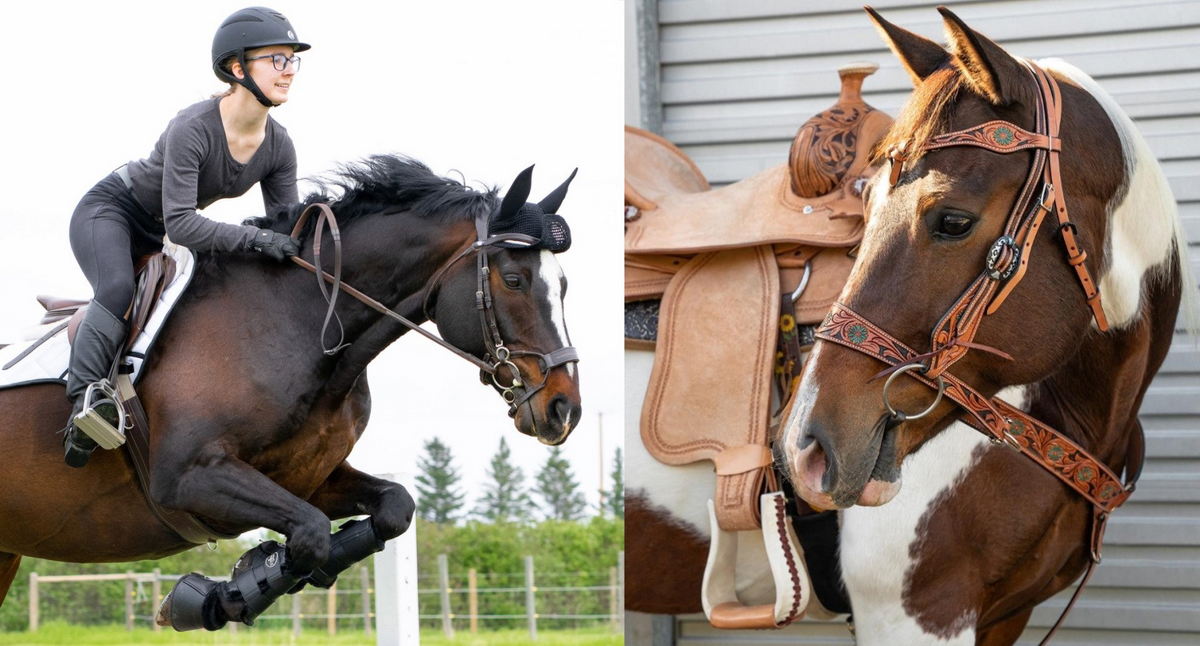

Riders often wonder whether they should learn Western or English riding. While both styles have the same basic principles of balance, control, and communication with the horse, they have distinct differences in tack, riding technique, and purpose.
Understanding these differences can help you choose the best riding style for your goals, experience level, and personal preference.
The main differences between Western and English riding come down to tack, rider position, rein handling, and the type of work the horse is expected to do.
✔️ Uses a larger, heavier saddle designed for comfort over long hours.
✔️ Focuses on one-handed rein control (neck reining).
✔️ Encourages a more relaxed seat and looser contact with the horse.
✔️ Commonly used for ranch work, rodeos, and trail riding.
✔️ Uses a lighter, closer-contact saddle for better communication.
✔️ Requires two-handed rein control with more direct contact.
✔️ Encourages a more upright posture and precise leg aids.
✔️ Commonly used for jumping, dressage, and eventing.
While both styles require balance and skill, the riding techniques, disciplines, and purposes vary significantly.
🐴 Western Riding developed from cowboy traditions in North America. Ranchers needed a comfortable saddle for long cattle drives and a way to steer cattle with one hand while using a lasso with the other. This led to the Western saddle, neck reining, and the relaxed riding style we see today.
🐴 English Riding has roots in European cavalry traditions. Soldiers needed precise control over their horses for warfare, hunting, and dressage, which led to closer-contact saddles and refined riding techniques. Over time, English riding evolved into disciplines like jumping, fox hunting, and dressage.
While Western riding was built for ranch work and open spaces, English riding was designed for speed, agility, and technical skill.
Western saddles are larger and distribute weight, making them ideal for long rides. English saddles are lighter and allow more movement, making them better for jumping and performance sports.
English riding requires more active leg and rein aids, while Western riding allows for more natural movement and relaxed cues.
✔️ Reining – Like dressage but with fast spins and sliding stops.
✔️ Barrel Racing – A timed event where riders race around barrels in a cloverleaf pattern.
✔️ Roping – A working cowboy skill where riders lasso cattle.
✔️ Western Pleasure – Judged on the horse’s calm, smooth movement and obedience.
✔️ Trail Riding – A casual or competitive discipline testing a horse’s maneuverability over obstacles.
✔️ Dressage – A highly precise discipline where horses perform patterned movements with elegance.
✔️ Show Jumping – Riders guide their horses over obstacle courses at high speeds.
✔️ Eventing – A combination of dressage, cross-country, and jumping.
✔️ Hunt Seat – A style of flatwork and jumping, often seen in equitation classes.
✔️ Endurance Riding – Long-distance riding that tests a horse’s stamina and condition.
Each riding style has competitive and recreational options, so choosing a style depends on your riding goals.
Both Western and English riding have learning curves, but Western riding is generally easier for beginners.
✅ Western Saddles Provide More Stability – The deep seat and horn offer more security.
✅ Neck Reining is Simpler Than Direct Reining – Riders don’t need as much rein finesse.
✅ Gaits Are Smoother and More Relaxed – The Western jog and lope are often easier to sit.
However, English riding builds core strength and balance more quickly, making the transition to other riding disciplines smoother.
The best way to decide is to try both styles and see which one feels more natural to you.
Still unsure which style to choose? Consider the following:
✔️ If you love rodeos, trail riding, or ranch work → Western riding is a great fit.
✔️ If you want to jump, do dressage, or compete in shows → English riding is better.
✔️ If comfort and leisure are your priority → Western offers a more relaxed experience.
✔️ If precision and skill development matter most → English riding builds technical riding ability faster.
At the end of the day, both styles teach horsemanship, balance, and control. The most important thing is to enjoy your time in the saddle, no matter which discipline you choose.
Both Western and English riding have unique traditions, equipment, and disciplines, but they share a common goal—creating a strong connection between horse and rider.
If you’re new to riding, don’t be afraid to experiment with both styles. Many riders enjoy switching between English and Western disciplines depending on their goals and interests.
No matter which style you choose, the most important thing is to ride with confidence, care, and enjoyment!
Get a photoshoot with edited photos
Book by to secure this special rate